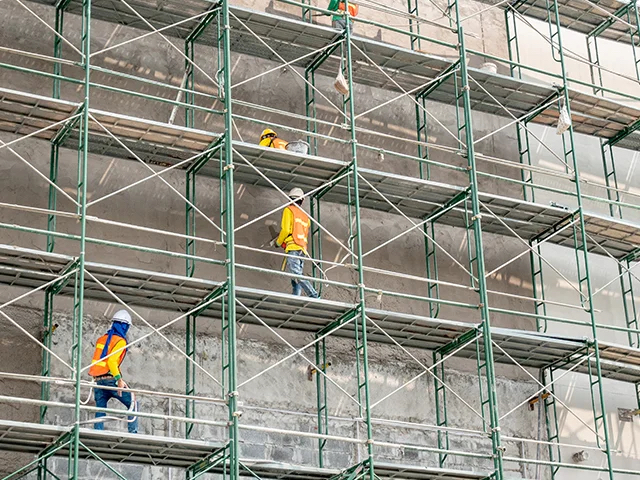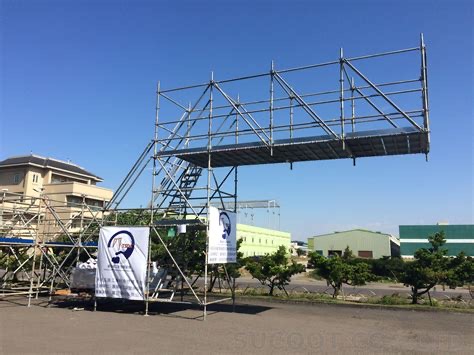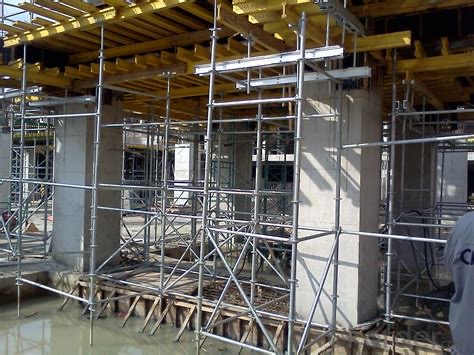Content Menu
● Introduction to the Ring Scaffold System
● Key Advantages of the Ring Scaffold System
● Comparison with Other Scaffolding Systems
● Specific Applications Where Ring Scaffold Systems Excel
● Potential Disadvantages of the Ring Scaffold System
● Conclusion
● FAQ
>> 1. What is a Ring Scaffold System?
>> 2. What are the main advantages of using a Ring Scaffold System?
>> 3. How does the Ring Scaffold System compare to tube and clamp scaffolding?
>> 4. What types of projects are best suited for the Ring Scaffold System?
>> 5. What are some potential disadvantages of using a Ring Scaffold System?
● Citations:
In the dynamic world of construction, selecting the appropriate scaffolding system is a critical decision that directly impacts project safety, efficiency, and cost-effectiveness. While various scaffolding options are available, the Ring Scaffold System, also known as ringlock scaffolding, has gained considerable traction due to its versatility and robustness. This article provides a comprehensive comparison of the Ring Scaffold System with other common scaffolding systems, highlighting its strengths, weaknesses, and specific applications to aid construction professionals in making informed decisions.

Introduction to the Ring Scaffold System
The Ring Scaffold System is a modular scaffolding system characterized by its unique rosette or ring connector, which allows for multiple connections at various angles. This system comprises vertical posts (standards), horizontal braces (ledgers), diagonal braces, base collars, and working platforms[5]. The key feature of the ringlock system is the rosette, which provides up to eight connection points in one plane, enabling versatile configurations for both straight and curved structures[4]. The Ring Scaffold System is known for its high load-bearing capacity, stability, and ease of assembly, making it suitable for a wide range of construction and maintenance projects[6][9].
Key Advantages of the Ring Scaffold System
The Ring Scaffold System offers several key advantages that set it apart from other scaffolding systems:
- Versatility and Flexibility: The rosette design allows for connections at multiple angles, making it adaptable to complex geometries and irregular structures[1][5]. This versatility is particularly beneficial for projects involving curved facades, circular tanks, or intricate architectural designs[7].
- Fast Erection and Dismantling: The modular components and pre-engineered connections enable rapid assembly and disassembly, reducing labor costs and project timelines[1][4]. A hammer is typically the only tool required for assembly, simplifying the process[4].
- High Load-Bearing Capacity: The robust construction and secure connections of the Ring Scaffold System provide a high load-bearing capacity, making it suitable for supporting heavy materials and equipment[6][8][9]. This is particularly important for projects involving concrete work, steel erection, or other heavy-duty applications[7].
- Enhanced Stability: The Ring Scaffold System's design provides excellent stability, ensuring a safe working platform for construction personnel[9]. The diagonal braces and secure connections contribute to the overall rigidity of the structure.
- Reduced Errors: The prefabricated connection points and modular components minimize the potential for errors during assembly[4]. This reduces the need for rework and ensures a safer and more reliable scaffolding structure.
- Easy Storage and Transportation: Despite its strength and stability, the Ring Scaffold System is relatively lightweight and compact for storage and transportation[4][9]. The components blend well with one another, facilitating efficient stacking and minimizing space requirements[4].
- Durability and Longevity: The Ring Scaffold System is often constructed with a hot-dip galvanized finish, providing excellent resistance to rust and corrosion[5]. This ensures a long service life, even in harsh environments.
Comparison with Other Scaffolding Systems
To fully appreciate the advantages of the Ring Scaffold System, it's essential to compare it with other common scaffolding systems:
1. Tube and Clamp Scaffolding:
- Description: Tube and clamp scaffolding consists of steel tubes connected by various types of clamps[1]. It's a traditional system known for its flexibility and adaptability.
- Ring Scaffold System Advantages: The Ring Scaffold System offers faster erection and dismantling times, reduced labor costs, and greater stability compared to tube and clamp scaffolding[1][4]. The prefabricated connections of the Ring Scaffold System also minimize the potential for errors.
- Tube and Clamp Advantages: Tube and clamp scaffolding can be more adaptable to extremely complex geometries and may be more cost-effective for small, simple projects.
2. Frame Scaffolding (H-Type Scaffolding):
- Description: Frame scaffolding consists of pre-fabricated frames connected by cross braces. It's a simple and cost-effective system commonly used for residential construction and general maintenance[2].
- Ring Scaffold System Advantages: The Ring Scaffold System offers greater versatility, higher load-bearing capacity, and improved stability compared to frame scaffolding[9]. The Ring Scaffold System can also be adapted to more complex structures.
- Frame Scaffolding Advantages: Frame scaffolding is generally faster to assemble for simple, rectangular structures and is more cost-effective for low-height applications[2].
3. Mobile Scaffolding:
- Description: Mobile scaffolding consists of a tower structure mounted on wheels, allowing for easy movement around the worksite.
- Ring Scaffold System Advantages: The Ring Scaffold System offers greater stability and load-bearing capacity compared to mobile scaffolding. It's also more suitable for projects requiring access to multiple levels or complex geometries.
- Mobile Scaffolding Advantages: Mobile scaffolding provides unmatched convenience for tasks requiring frequent repositioning on flat, even surfaces.
4. Timber Scaffolding:
- Description: Timber scaffolding consists of wooden poles and planks. It's a traditional system that is rarely used in modern construction due to safety concerns and limited load-bearing capacity.
- Ring Scaffold System Advantages: The Ring Scaffold System offers significantly greater strength, stability, and safety compared to timber scaffolding.
- Timber Scaffolding Advantages: Timber scaffolding may be more readily available and cost-effective in some remote areas, but its use is generally discouraged due to safety risks.

Specific Applications Where Ring Scaffold Systems Excel
The Ring Scaffold System is particularly well-suited for the following applications:
- Complex Structures: Projects involving curved facades, circular tanks, or intricate architectural designs benefit from the Ring Scaffold System's versatility[1][5][7].
- Heavy-Duty Applications: Projects requiring high load-bearing capacity, such as concrete work, steel erection, and bridge construction, are ideal for the Ring Scaffold System[6][7][8][9].
- Projects with Limited Space: The Ring Scaffold System's compact components and efficient assembly methods make it suitable for projects with limited space or congested worksites[4].
- Projects Requiring Frequent Modifications: The modular design of the Ring Scaffold System allows for easy modifications and adjustments to accommodate changing project requirements[5].
- Shoring: The ringlock system is used along with other Doka systems to reinforce old buildings while rebar works and concrete pouring are being prepped[7].
Potential Disadvantages of the Ring Scaffold System
Despite its numerous advantages, the Ring Scaffold System also has some potential drawbacks:
- Higher Initial Cost: The initial investment in a Ring Scaffold System may be higher compared to some other scaffolding systems, such as frame scaffolding[2].
- Requires Trained Personnel: While the Ring Scaffold System is relatively easy to assemble, proper training is essential to ensure safe and efficient erection.
- Hammer Required for Assembly: The need for a hammer during assembly may be a minor inconvenience for some users[2].
Conclusion
The Ring Scaffold System is a versatile, robust, and efficient scaffolding solution that offers numerous advantages over traditional scaffolding methods. Its rosette design, high load-bearing capacity, and ease of assembly make it suitable for a wide range of construction and maintenance projects, particularly those involving complex geometries, heavy loads, or limited space. While the initial cost may be higher compared to some other systems, the long-term benefits in terms of safety, efficiency, and durability make the Ring Scaffold System a worthwhile investment for construction professionals seeking to optimize their worksite productivity.

FAQ
1. What is a Ring Scaffold System?
A Ring Scaffold System, also known as ringlock scaffolding, is a modular scaffolding system characterized by its rosette connector, which allows for multiple connections at various angles[5].
2. What are the main advantages of using a Ring Scaffold System?
The main advantages include versatility, fast erection and dismantling, high load-bearing capacity, enhanced stability, reduced errors, and easy storage[1][4][6][8][9].
3. How does the Ring Scaffold System compare to tube and clamp scaffolding?
The Ring Scaffold System offers faster erection and dismantling times, reduced labor costs, and greater stability compared to tube and clamp scaffolding[1][4].
4. What types of projects are best suited for the Ring Scaffold System?
The Ring Scaffold System is well-suited for projects involving complex structures, heavy loads, limited space, or frequent modifications[5][7].
5. What are some potential disadvantages of using a Ring Scaffold System?
Potential disadvantages include higher initial cost and the need for trained personnel[2].
Citations:
[1] https://www.scafom-rux.com/en/scaffolding-blog/5-reasons-to-use-a-ringlock-system-scaffold
[2] https://www.oguzhaniskele.com/en/blog/what-is-the-difference-between-ring-lock-and-h-type-scaffolding
[3] https://www.safesmartaccess.co.nz/5-reasons-for-using-ring-lock-scaffolding/
[4] https://www.totalcontec.com/what-is-ringlock-scaffolding-system/
[5] https://apacsafety.com/ultimate-guide-of-ringlock-scaffold/
[6] https://www.tytruss.com/newsclass_3/the-pros-and-cons-of-ringlock-scaffolding.shtml
[7] https://www.doka.com/en/system-groups/doka-working-scaffold-systems/working-scaffolds/ringlock/ringlock
[8] https://www.linkedin.com/pulse/5-advantages-ringlock-scaffolding-system-kevin-ng
[9] https://aaitscaffold.com/ringlock-scaffolding/advantages-of-ringlock-scaffolding-system/






















